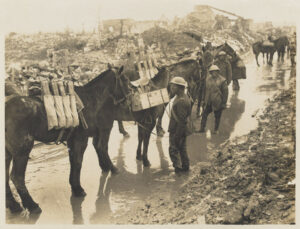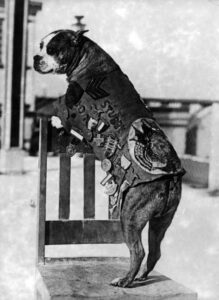#ForgottenFriday – Pet Remembrance Day
In this week’s #ForgottenFriday, we are celebrating Pet Remembrance Day (5th July). In remembrance of the many pets and animals that contributed to the war, we are learning all about the different types of service they took part in.
When we think of the world wars, images of soldiers in trenches, tanks rumbling across battlefields, and planes soaring through the skies dominate our minds. Yet, amid the human struggle and technological advancements, there lies a largely untold story of the animals who played crucial roles in both the First and Second World Wars. These creatures, often overlooked in history books, displayed remarkable bravery and provided invaluable assistance, demonstrating that the concept of heroism extends beyond humanity.
Below we are discovering the types of animals we used during warfare!
Horses and Mules: The Workhorses of War
In an era when mechanised vehicles were still in their infancy, horses and mules were essential for transportation. They hauled artillery, ammunition, medical supplies, and other crucial equipment across treacherous terrains. The conditions were often brutal, with mud, barbed wire, and constant shelling making their tasks horrifically perilous. Despite this, these animals carried on, their strength and endurance proving vital to the logistics of war. During World War Two Horses and Mules were still indispensable. Despite advancements in technology, horses and mules were still heavily used, especially in regions where mechanized transport was impractical. They were crucial in the rugged terrains of North Africa, the mountains of Italy, and the vast expanses of the Eastern Front.

Horses carrying ammunition, 1917 (c)
Photograph, World War One, Western Front (1914-1918), 1917 (c).
During the war thousands of horses, mules and donkeys served with British forces on the Western Front. They were used to carry supplies and ammunition, transport the wounded and pull guns. Thousands of animals were killed or wounded, while others succumbed to fatigue and disease.
From a photograph album of 253 photographs compiled by Charles William Stulpnagel (known as Swinton after December 1914), 1889-1920.
NAM Accession Number
NAM. 1953-03-31-182
(c) National Army Museum, Out of Copyright
Dogs: The Soldiers’ Best Friends
Dogs served in numerous roles during the First World War. They acted as messengers and scouts and were also employed in search and rescue missions. One notable canine hero was Sergeant Stubby, a Boston Terrier who became the most decorated war dog of World War I. Stubby participated in 17 battles, used his acute sense of smell to warn soldiers of gas attacks, and even captured a German spy. How brilliant was he!!
Dogs’ roles expanded during the Second World War. They were trained for a variety of tasks, including detecting mines, guarding installations, and even laying communication cables. Chips, a German Shepherd-Collie-Husky mix, was one of the most famous war dogs. He served with the U.S. Army and was awarded the Distinguished Service Cross, Silver Star, and Purple Heart for his bravery.

Sgt Stubby

Chips the Dog
Pigeons: The Airborne Messengers
In an age before reliable radio communication, homing pigeons were used extensively to carry messages across enemy lines. These birds, capable of flying long distances, often through dangerous conditions, ensured that vital information reached its destination. Cher Ami, a famous pigeon, saved nearly 200 soldiers by delivering a critical message despite being injured by enemy fire. We tend to forget the ability of these fantastic creatures. Once again, during World War Two, pigeons played a crucial role in communication. The British employed around 250,000 pigeons during the war. One pigeon, G.I. Joe, is credited with saving over 1,000 lives by delivering a message that stopped the bombing of an Italian village occupied by British forces.

Cher Ami
Other Animals: The Unsung Contributors
World War II saw the use of other animals, such as cats and elephants. Cats were employed on ships to control rodent populations and being a well-loved pet, while elephants were used by the British in Burma for transportation and heavy lifting in challenging jungle environments.
Legacy and Recognition
The contributions of animals in both world wars have been recognised posthumously in various ways. Memorials and statues have been erected, and awards like the Dickin Medal, often referred to as the animal equivalent of the Victoria Cross, have been bestowed upon these brave creatures. The medal, established in 1943 by Maria Dickin, has honoured dogs, pigeons, horses, and even a cat for their wartime bravery and devotion to duty.
Conclusion
The story of animals in the First and Second World Wars is a poignant reminder of the diverse forms that courage and loyalty can take. These animals, thrust into the chaos of human conflict, displayed remarkable resilience and played indispensable roles. Their contributions, often at great personal cost, highlight a unique and moving aspect of wartime history. As we remember the human heroes of these global conflicts, let us also honour the four-legged, feathered, and hoofed warriors who served alongside them. We Will Remember Them.


